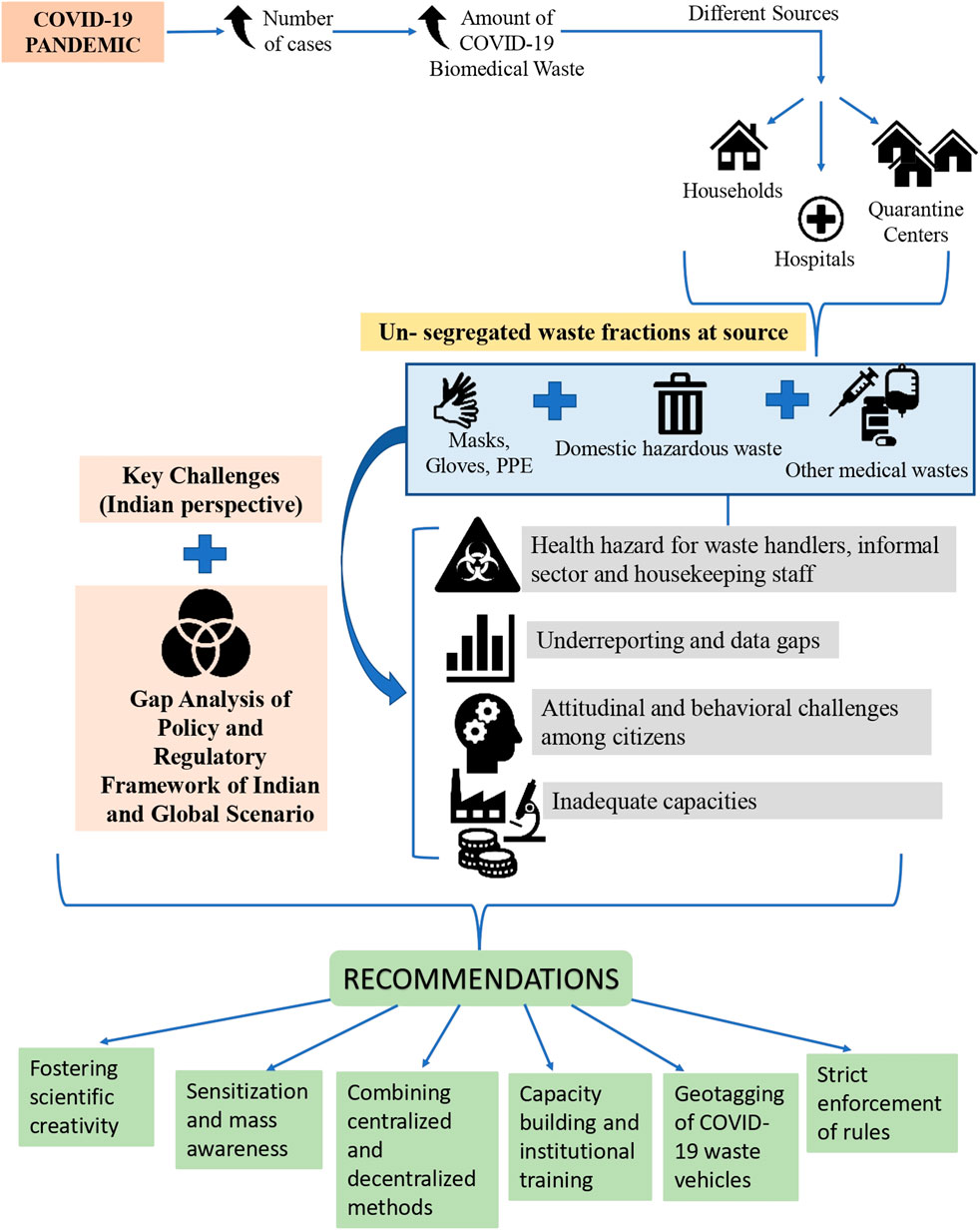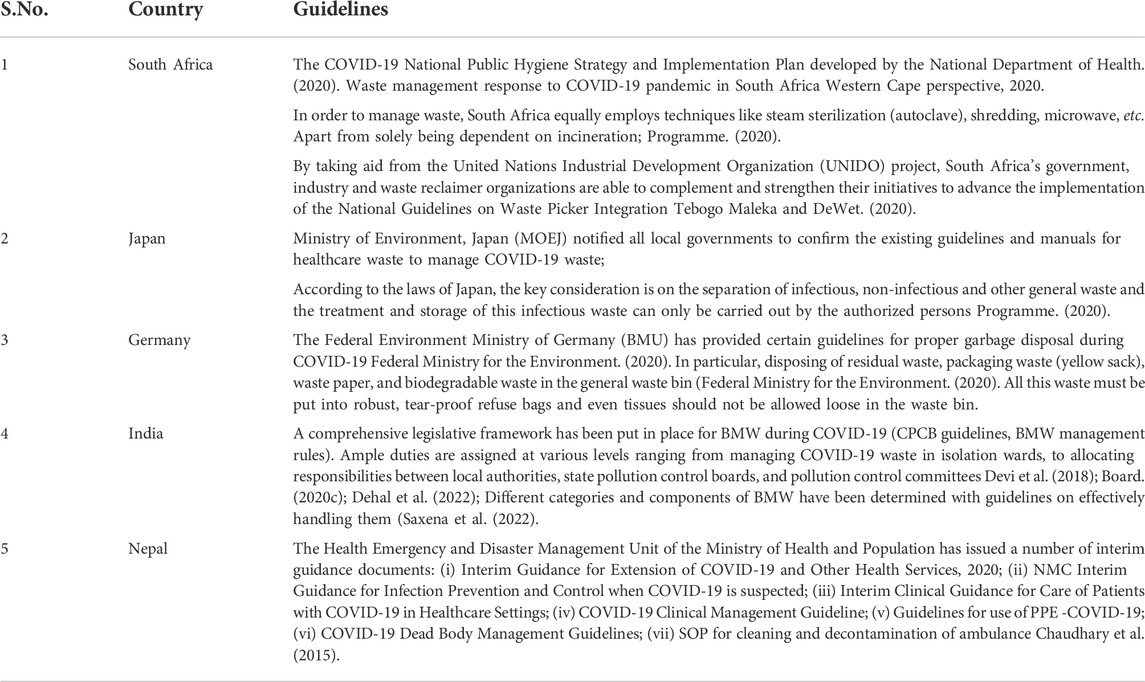- 1Department of Biomedical Science, Acharya Narendra Dev College, University of Delhi, New Delhi, India
- 2Department of Biomedical Science, Bhaskaracharya College of Applied Sciences, University of Delhi, New Delhi, India
- 3Technical Advisor, Deutsche Gesellschaft fur Internationale Zusaamenarbeit (GIZ) GmBH, New Delhi, India
- 4Department of Commerce, Sri Aurobindo College (Morning), University of Delhi, New Delhi, India
- 5Dean of Colleges, University of Delhi, New Delhi, India
Proper management of Biomedical Waste (BMW) is an essential component of any sustainable healthcare sector. With the burst of COVID-19 pandemic when every hospital and treatment facility was overburdened patients, efficient handling of the huge amount of generated BMW became a task for the entire world. This review compares the BMW generated before and during the second wave of COVID-19, highlights the challenges in managing the exuberated amount of COVID-19 waste and sites recommendations to promote sustainable design thinking, in order to address this grave concern in the current setting of the Indian system. The study indicated that inappropriate management of waste and the lacunae in the entire chain from segregation to collection until its disposal has posed a serious threat to the wellbeing of healthcare workers, sanitation staff as well as the operators and housekeeping staff at the hospitals, isolation centers and Municipal Corporation. Many states had inadequate number of common BMW treatment facilities (CBMWTFs) leading to inefficient treatment of the excess waste. The behavioural and attitudinal barriers of neglect and ignorance of different stakeholders further aggravated the problem of BMW management to manifolds. To achieve better management we recommend spreading awareness regarding the kind and infectious nature of waste generated by COVID-19 patients and their caregivers, segregation and decontamination of such waste at source and increasing the capacity as well as number of CBMWTFs. Creative ways to recycle the waste must be devised so as to reduce the burden on disposal sites.
1 Introduction
In December 2019 COVID-19 pandemic struck the entire world unprepared and its effects are still continuing. Till 1st August 2022 more than 578 million cases had been reported and the virus had caused over six million deaths worldwide. India alone reported a total of around 44 million cases and over 0.5 million deaths being second only to US (Dong et al., 2020). The pandemic not only affected the health of masses, but also adversely impacted the socio-economic status of countries across (Mofijur et al., 2021; Wei et al., 2021). The impact was more pronounced in South Asian countries like India due to large population, high poverty and poor healthcare facilities (Rasul et al., 2021; Gupta et al., 2022).
In the wake of the pandemic and the consequential lockdown in 2021, there were reports of both positive and negative impacts on the environment, On one hand many studies documented decrease in the rates of deforestation, reduction in vehicular emissions and improved air and water quality (Bates, 2020; Kaur, 2020; Nigam et al., 2021). However, the dark side was that the surging COVID cases increased the amount of plastic waste produced worldwide by around eight million tons from 2018 to August 2021, 46% of which was contributed by Asia alone (Peng et al., 2021). Production and use of single use disposable masks and plastic based personal protective equipment (PPEs) shot up drastically reflected by an increase in its global market of USD 50.9 billion in 2019 to USD 91.6 billion in 2021 (Research, 2017-2020, Research, 2022). In the beginning of the pandemic it was estimated by a reuters agency report that India would require around 0.1 million PPE kits per day and over 38 million masks to combat COVID-19. However, till January 2020, India had zero production of PPE kits and N-95 masks and relied solely on the imported stock of 2.75 lakhs. However, by the end of May 2020 India became the second largest manufacturer of PPE kits producing nearly 4.5 lakh PPE kits and more than 104 lakh N-95 masks (Lakshmanan and Nayyar, 2020). Panic buying of preventive medicines and consequentially their production took a major plunge (Ayati et al., 2020; Sulis et al., 2021). Lot of waste in the form of empty mineral water bottles and disposable crockery was produced from households due to people following home isolation (Filho et al., 2021; Urban and Nakada, 2021). This manifold increase in the waste generated due to COVID-19 further burdened the already saddled authorities to collect, manage and treat it in an appropriate manner (Das et al., 2021). Even before the pandemic, single use plastics were main constituents of marine litter, but the situation became more grave after COVID-19 (Patrício Silva et al., 2021; Roberts et al., 2022).
Most of the COVID-19 related wastes have an inherent potential risk of infection and can be perilous to both man and nature just as any other medical waste like blood stained bandages, syringes and infectious tissues which are equally toxic and hazardous (Singh, 2021). Since this is a special waste stream that needs to be addressed properly owing to its toxic and infectious nature, Central Pollution Control Board (CPCB), the regulatory authority of India - categorized it as the COVID-19 Biomedical Waste. Usually only 10%–25% of healthcare waste belongs to the category of BMW (Board and Ministry of Environment, 2016). However, in case of any pandemic all wastes are treated as BMW (Sarkodie and Owusu, 2021). Further, with limited beds available at the hospitals against the flooding COVID-19 cases, individual households and other quarantine centres became an added source of BMW generation (Board, 2020a; Naughton, 2020). To manage such a leap in BMW generation especially in a country like India where population is so high while the literacy rate and awareness is quite low, is surely an arduous task. The current review highlights the challenges faced, the gaps in the management strategies adopted and the need to increase awareness and inculcate behavioural change among all the citizens of India and other countries to manage this plethora of waste generated.
2 Biomedical waste generation due to rise in COVID-19 cases
It has been well documented from past outbreaks and epidemics that the amount of BMW generated during any health emergency is far higher than the normally generated healthcare waste (Agrawal et al., 2020). This is logical enough because as the number of patients increase, the demand, production and use of disease associated preventive, diagnostic and treatment commodities also increase. A comparison of the amount of BMW generated in different states of India in the year 2019 (pre COVID-19) with that in May 2021 (second wave) clearly demonstrates this (Figure 1). In order to see the association of increase in BMW generation with the rising COVID-19 cases, we categorized Indian states into three sets; States with high (>10,000), moderate (4,000–10,000) and low (<4,000) number of COVID-19 cases averaged from 1 May 2021 to 10 May 2021. The BMW generated during the same period was also averaged (Table 1). Interestingly, most of the states showing high number of COVID-19 cases also showed high COVID related BMW production. As a representation, the average amount of waste produced by high, moderate and low COVID-19 reporting states was plotted along with their respective average case numbers (Figure 2). The graph clearly indicated that level of COVID related BMW was significantly higher in states with more number of COVID-19 cases and vice versa (Board, 2020–2021).
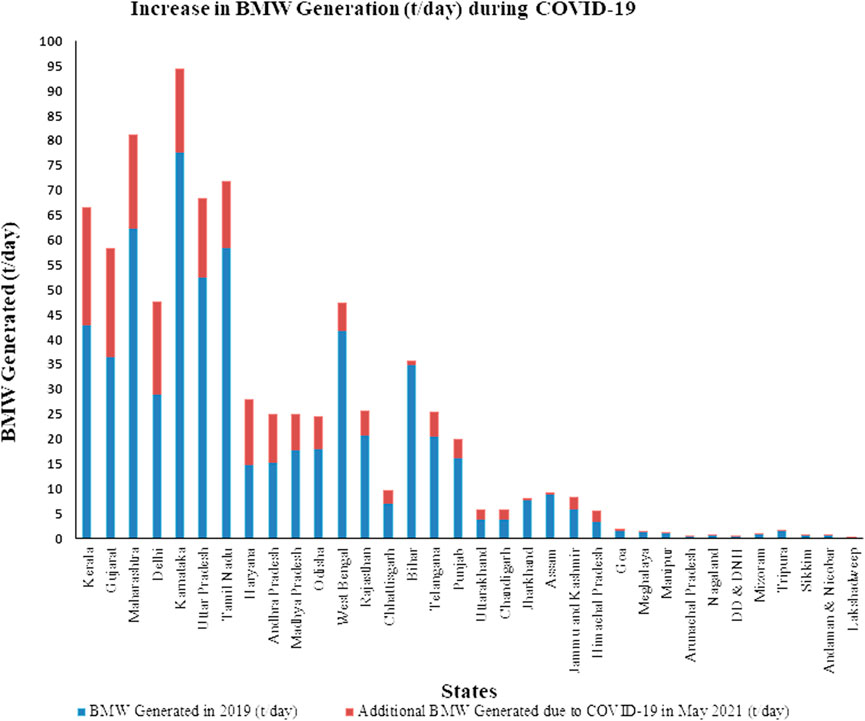
FIGURE 1. Comparison of BMW generated before and during second wave of COVID-19 pandemic. Most of the states generated a considerable amount of extra BMW during COVID-19 (represented by the red bar segment) as compared to the pre-COVID time.
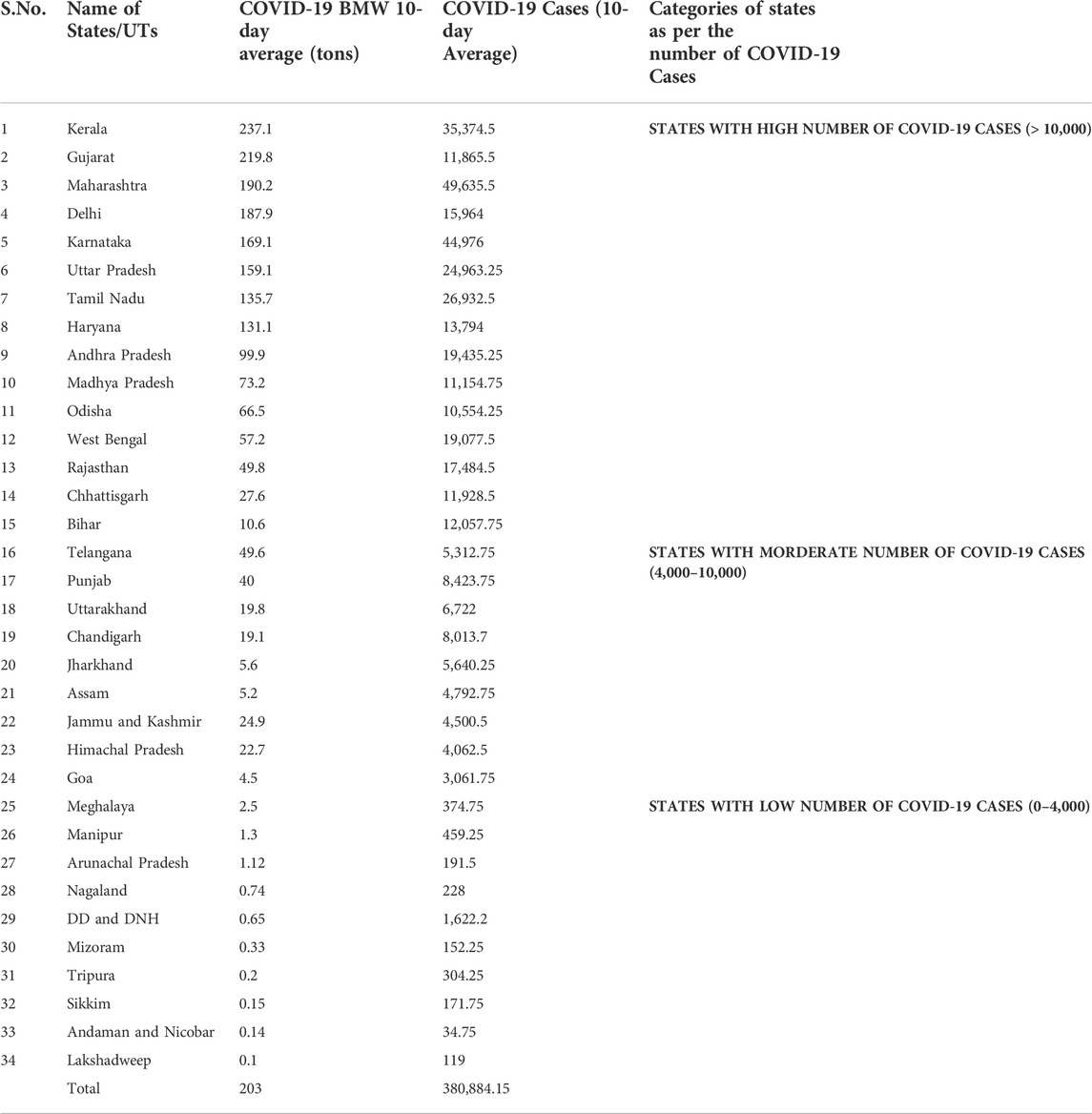
TABLE 1. Categorizing Indian states according to high, moderate and low number of COVID-19 Cases in May 2021.
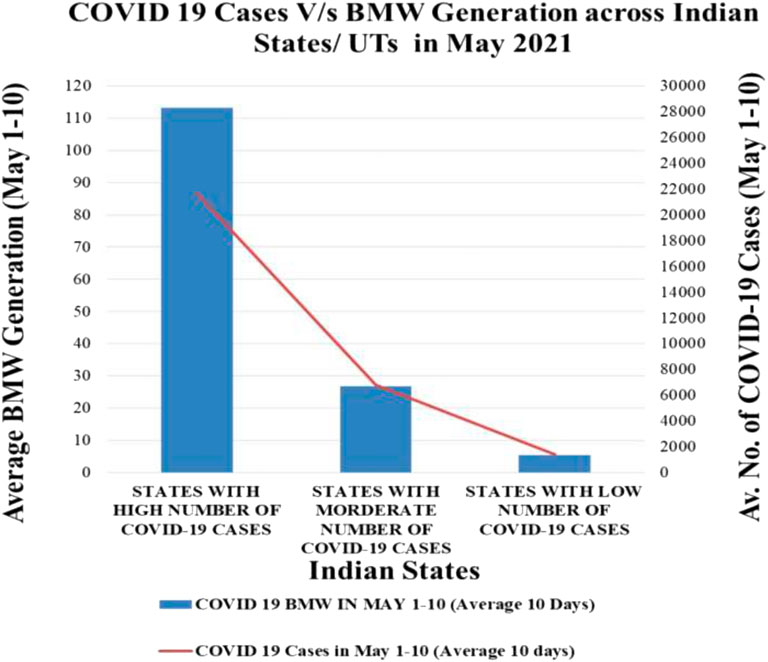
FIGURE 2. COVID-19 Cases vs. BMW Generation across Indian states in May 2021. The trend of waste generated (represented by blue bars) in three different categories of states was apparently similar to the trend line (red line) representing the average number of COVID-19 cases in these states during the first 10 days of May 2021. The numbers on right depict BWM generation (in tons per day) and numbers on left depicts average number of COVID-19 cases for the said period.
Further on, a Pearson’s correlation curve (Figure 3) of month wise active COVID-19 cases versus COVID-19 related BMW generated (Board, 2021) in India from January 2021 to May 2021 revealed a strong positive association between the two (r = 0.9773), re-affirming that the increase in BMW was indeed due to rising COVID-19 cases. The data for May 2021 was only available till 10 May 2021, so the active COVID cases data was also taken and averaged for the first 10 days of May 2021.
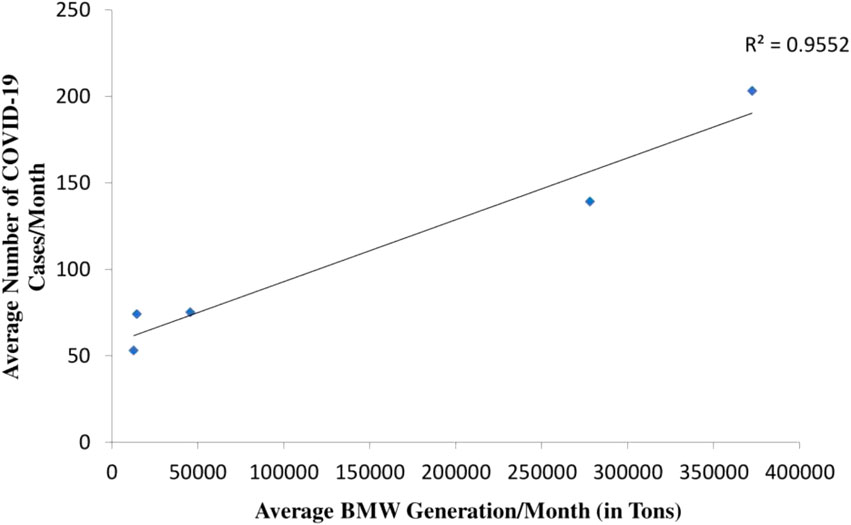
FIGURE 3. Pearson correlation analysis between average COVID-19 cases/month vs. average BMW generation/month (in tons) in India from January 2021 to May 2021. The graph depicts a strong positive association between the two variables (r = 0.9773).
3 Challenges in treating the increasing COVID-19 waste in India
The plethora of waste generated due to the COVID-19 pandemic was itself a huge problem to tackle for any country. However, in India many other challenges added to the burden of managing this huge amount of waste (Figure 4).
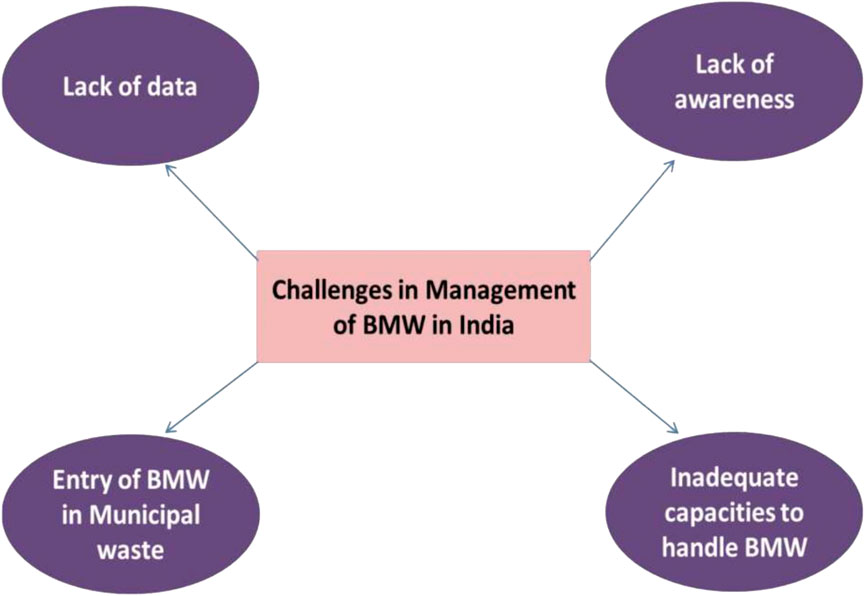
FIGURE 4. Challenges in managing COVID-19 BMW in India. The given figure identifies four major grey areas that the biomedical waste management (BMW) system of India is facing. These include data gaps and its unavailability, lack of awareness among citizens and waste handlers, the mix-up of municipal waste and BMW and the inadequate capacities to manage this waste in the country.
3.1 Lack of data
There is a lack of sufficient and authentic data on the amount of COVID waste generated from hospitals and households that will enable the authorities to formulate necessary action plan, installation of treatment facilities and develop strategies for managing the waste in a sustainable manner. It is very critical to identify hotspots of waste generation, secondary collection sites for transportation and its disposal (Manekar et al., 2022; Saxena et al., 2022). Lack of geographical identification leads to mixing of waste fractions as well as its inappropriate processing and disposal.
In spite of the Supreme Court’s issuance of a mandatory reporting requirement through the BWM App, only a few states/UTs have registered and only a handful of them report consistently. The CPCB Waste Tracking App has not been used in some states, such as the Andaman and Nicobar Islands, Arunachal Pradesh, Goa, and Sikkim (Saxena et al., 2022). The CPCB presentation of the biomedical waste management data has revealed critical gaps in the reporting. In May 2021, for example, BMW’s waste generation data is available for the first 10 days, but it is not available for the entire month (Board, 2021). In addition, the issue of illegal dumping of collected waste into unoccupied open spaces increases manifolds due to the lack of proper records and checks (Swaminathan, 2018).
3.2 Changes in the household waste composition and lack of awareness
Due to scarcity of beds available at the hospitals against the flooding COVID-19 cases, many quarantine centres were developed and people also had to switch to home isolation (Siddiqui et al., 2020; Yasmeen, 2021). As a result, individual households and these quarantine centres became an added source of BMW generation (Filho et al., 2021) and lead to a drastic change in the composition of municipal waste (Sarkodie and Owusu, 2021). If we focus specifically on the household waste, then we can observe that apart from domestic household waste, the components also include PPE kits, masks, shoe covers, gloves and single use plastic packaging (Anne Scheinberg et al., 2020; Filho et al., 2021; Sarkodie and Owusu, 2021). The challenges posed by such changes in waste composition are manifolds ranging from existing concern of its treatment to potential hazard for untrained handlers and rag pickers and ignorant behaviour of people while disposing COVID-19 waste in the same dustbin as the other household waste.
There is an inadequacy of knowledge on waste management issues among citizens, and carelessness on their part creates problems for the municipalities (Kumar and Agrawal, 2020). According to a study in the New England Journal of Medicine, the viability of viruses on different components of household waste is significant ranging from cardboard on which the virus stays for 24 h to plastics on which the virus can stay up to 72 h. Thus, the common household waste, when mixed with discarded masks, gloves and PPEs, poses serious health concerns (Manjua, 2020). Ideally such waste should be sent to a biomedical waste facility for proper secondary treatment and disposal but in reality it was being dumped openly or ended up in the landfills (Singh, 2021). Several studies have been conducted regarding the COVID waste generation and its disposal practices adopted (Anne Scheinberg et al., 2020; Naughton, 2020; Filho et al., 2021; Sarkodie and Owusu, 2021; Saxena et al., 2022). One of the studies conducted by an organisation namely Toxics Link in 2019 under the title “Spreading infections?” pointed to infectious waste being dumped as part of municipal solid waste at healthcare facilities and hospitals in Delhi’s 11 districts. The study results showed that 27.8% of the facilities did not even have needle cutters, which are required by regulations regarding needle disposal. Three-quarters of the facilities did not have wheeled waste transportation, due to which hazardous waste was frequently moved through patient areas. Another alarming 26.4% of the surveyed facilities discharged liquid waste in the open drains.
In India, about five million sanitation workers resides, out of which 50 percent are women, who are into cleaning garbage and collecting waste from households and quarantine centres (Chature and Gupta, 2020; Mishra, 2020). The informal sector or waste pickers are responsible for more than 50% of segregation of recyclable waste fractions comprising of paper, plastic, metal and glass, however due to improper working conditions and rummaging through the domestic hazardous waste while segregating only recyclables leads to occupational hazards and impacting their health. Many studies have reported that the face covers and protective kits used by the common public could provide an ideal environment for the virus to multiply (Mallapur, 2020). Thus, if not properly discarded, they can become a potential threat of infection to the sanitation workers as well as the environment. Due to lack of proper training and awareness, many of these masks find their place ultimately in the open dumpsites which are unmanaged and are openly burned leading not just to health threats, but also exuberate environmental issues like air and soil pollution (Chapman, 2021).
According to the report by The NEW Indian Express, the sanitation workers of Chennai reported instances of anxiety while handling household waste mixed with used face masks (Mallapur, 2020; Service, 2020). As the production and use of masks and safety gear increased, the focus was primarily upon wearing face masks and not on ways of its hygienic disposal (Mallapur, 2020). Moreover, there has been a reported lack of access to the protective equipment for sanitation workers. Most of the time, these workers wear overused masks which do more harm than good. Thus, in order to secure their livelihoods in the long term, there is a requirement to create favorable conditions for these workers such as proper training, awareness and required protection so that they could work with respect, safety and reassurance during hard times (Huges, 2020).
3.3 Inadequate facilities to handle BMW
According to the CPCB data 517 tons/day of biomedical waste was generated in the year 2015–2016, while approximately 619 tons/day was generated during the year 2018–2019. The amount of BMW projected to be generated by 2022 was 775.5 TPD. To grapple with this huge amount of waste, 199 common bio-medical waste treatment facilities (CBWTFs) were engaged in 2016 and 202 in 2019, while 35 CBWTFs were under construction. Yet, the efficiency of BMW management was not 100%. However, the onset of COVID-19 pandemic led to massive BMW generation as compared to the normal projections for the year 2020 and 2021. In May 2021 when the maximum number of COVID cases was reported, BMW generation increased to around 800 tons/day (Board, 2020-2021), even more than what was projected for 2022. However, throughout the pandemic period from June 2020 to May 2021 even though the COVID waste produced added 15%–20% more burden to the already existing amount of waste produced, yet the number of Common Biomedical Waste Treatment Facilities (CBWTFs) engaged to tackle it remained same (Table 2).
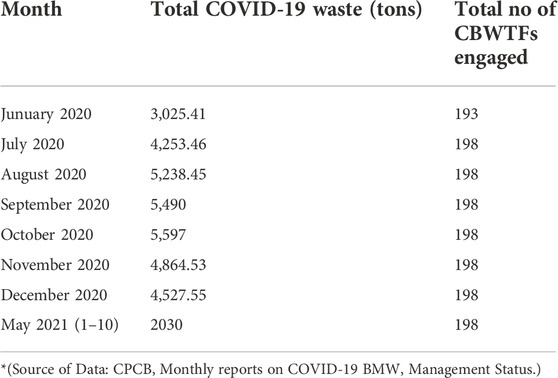
TABLE 2. COVID-19 BMW generated vs. total number of CBWTFs engaged in India*.
If we compare this with the past trends of 2017, out of 200,000 tons of generated BMW in India, only 78% was treated and the rest was disposed of into deep burials (Manjua, 2020). This clearly means that the handling and management of BMW was a challenge in India, even before COVID-19 pandemic. Lack of funds, shortage of equipment and deficiency of trained BMW handlers were major reasons for this challenge (Datta et al., 2018). Since beginning, most of the BMW was being disposed of through incineration and the left out untreated waste ended up in open landfills and dump sites becoming sources of infection to sanitation workers and environmental hazard. With such a scenario of loopholes in the existing setup, when the COVID-19 pandemic hit the country, the high amount of infectious BMW generated required high temperatures of about 900°C–1,200°C for proper disposal through incineration, as per the CPCB guidelines. (Behera, 2021). However, due to high amounts, improper segregation at source and micro-plastic composition of disposed protective gear, a startlingly huge amount of plastic was ending up in the incinerators (Singh, 2021). This improper practice of incinerating everything not only degrades the quality and efficiency of the limited number of available incinerators (Singh, 2021), but also become a source of toxic gases like furans and dioxins. These are potential pollutants and also causes of cancer, neurotoxicity and immunotoxicity to the exposed humans (Olvera, 2019; Behera, 2021).
The major reason behind this mismanagement could be due to lack of proper training provided to the BMW handlers, lack of adequate facilities and the ignorant behaviour due to increasing workload of managing huge amounts of BMW transported every day from the healthcare centers. Thus, there is a critical need to ensure that the responsibility of managing the COVID-19 BMW goes to the hands of trained workers who are given proper PPEs while working with BMW. Moreover, periodical awareness drives shall be conducted in order to keep a check on their attitudinal and behavioural aspects while managing waste. In order to overcome the shortage of treatment facilities and incinerators, the use of alternatives like autoclave, microwave and chemical methods should be promoted to treat the increasing amount of BMW generated from different sources.
4 Gap analysis of policy and regulatory framework: Indian and global scenario
With respect to global scenario, many guidelines to manage the infectious waste have been issued by different international bodies and academic organizations (Programme, 2020; Liang et al., 2021). Guidelines have been put forward by UN Habitat (Habitat, 2020–2021), International Solid Waste Association (ISWA) (Anne Scheinberg et al., 2020), Unitedbib_habitat_2020_2021 Nations Environment Program (UNEP), (Programme, 2020), World Health Organization (WHO) (Capoor and Parida, 2021) and other country specific norms (CDC), 2020; Board, 2020b; Commission, 2020) to manage the COVID-19 waste, one of the critical challenges during the COVID-19 pandemic. On an international level, there are about 168 national laws that specifically focus upon BMW. Of these, 57 laws emphasize only on healthcare waste streams and 111 laws put spotlight on multiple streams of waste (Programme, 2020).
The guidelines or advisories elaborate the kind of waste generated and provide the key responsibilities of different stakeholders along with the step-by-step process of proper segregation, collection and safe disposal of COVID-19 related waste. Table 3 provides the guidance or advisories issued to manage the COVID-19 waste in an effective manner.
This table highlights various important guidelines that India and other countries have laid down to combat the risks associated with COVID-19 waste. India, as a developing nation, can adapt these guidelines proposed by other countries to strengthen its existing systems and address the current loopholes.
Although measures have been outlined to combat COVID-related waste, enforcing and implementing them seems difficult due to the inadequate infrastructure and lack of resources. Especially in geographically isolated areas such as the islands of Andaman and Nicobar and Lakshadweep or in high-altitude mountainous regions, monitoring of compliance with guidelines and procedures is crucial (Board, 2019; Dehal et al., 2022). Similarly, citizens’ awareness levels and behaviours regarding proper waste segregation, collection and disposal are also important to monitor and improve. Contrary to Japan, India places a high priority on the general collection and transportation of waste from isolation wards and treatment facilities (Programme, 2020). The majority of workers involved in this process are unskilled, meaning that source separation has a negative impact on the situation (Corburn et al., 2020; Galanis et al., 2021). Thus, instead of hiring multiple unskilled sanitation workers, it is important to provide the workers with adequate training and protective equipment along with maintaining a record of the generated COVID-19 waste. In addition, it is essential that India decrease its reliance on incineration and consider alternative techniques along with collaborating with UN programs on BMW management.
5 Recommendations
The COVID-19 pandemic led to immense dependence and demand on generation of more single use plastics or disposable plastics, PPEs etc., making the waste management system more vulnerable and fragile (Luhar et al., 2022). There is a need to curb the usage of disposable masks, PPE kits and other disposable waste that is increasing the generation of waste during the pandemic and compromising our health and the environment. It is utmost important to provide viable technological solutions along with behavioral as well as institutional changes for managing waste in a scientific manner (Vanapalli et al., 2021). To bring this change, it is necessary to involve stakeholders, informal sector, academicians, think tanks and manufacturers and all the citizens (Keith Alverson et al., 2021) in this cause, Based on the secondary research, literature review and the experiences witnessed during the pandemic, the recommendations presented below could address the complex and diverse situation of managing the complex waste fraction generating from households as well as hospitals:
5.1 Data management and utilization of digital innovation for adequate monitoring
Data is an important aspect of planning and policy measures. However lack of data leads to improper planning and response mechanism towards any emergency, where resource allocation is most important for relief mechanisms. To strengthen the monitoring mechanism and gathering accurate data, advanced digital innovations must be employed (Brahmbhatt et al., 2022). Internet of things, Blockchain technology or Artificial intelligence can act as a game changers for traceability of contacts, alerts and warning systems, mapping of potential hot spots and timely support during and post the pandemic (Abd-alrazaq et al., 2021; Sheeraz et al., 2021). Furthermore, integrating all stakeholders at one platform will ensure immediate action and timely support in terms of collection as well as transportation of COVID waste from the hotspots to the biomedical processing facility.
5.2 Robust communication strategy
A robust communication strategy can be developed for creating mass awareness amongst citizens about the negative consequences of unsegregated mixed waste on health and the environment. Creating awareness through Information Education and Communication (IEC) activites like regular trainings of sanitary workers and operational staff, performance of jingles and nukkad nataks in schools, residential areas and communities can be quite useful.
5.3 Promoting sustainable alternatives for consumption and production
It has been reported that 22 million tons of plastic leaked in the environment in 2019 which is projected to be double by 2060 (Chowdhury et al., 2022). The growth in Single use plastic (SUP) such as gloves, face masks, face shields, PPE kits has added pressure on authoriites to manage the waste efficiently (Patrício Silva et al., 2020). To address this concern, efforts need to be made to find innovative ways of recycling and reusing masks (Figure 5) in order to reduce the burden on landfills (Ahmed and Lim, 2022; Idrees et al., 2022). There should be a mechanism developed for incentivizing and giving rewards to people developing such methods. R&D sectors must be promoted and startups for post-consumer recycling process of the SUPs should be encouraged to retrieve usable material through a process of sterlisation and further extraction through sorting machines (Vanapalli et al., 2021). The plastic fraction recovered can then be converted to either granules that can be further utilised or upcycled.
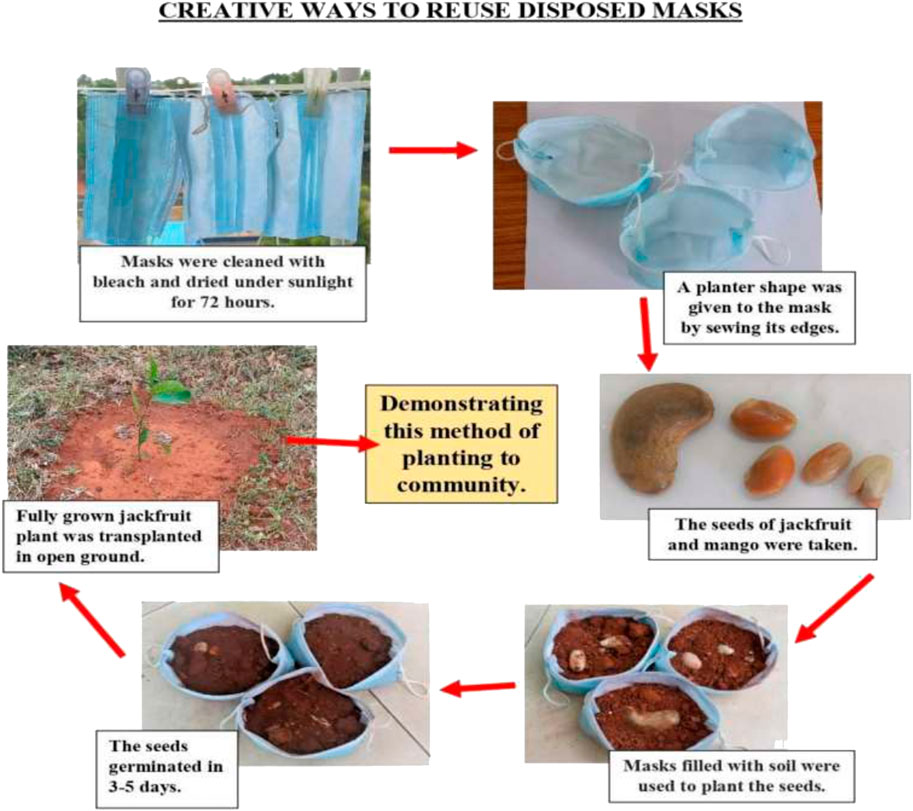
FIGURE 5. Innovation and Creativity to reduce the number of masks in landfills. The disposed COVID-19 masks can be repurposed into seedling planters after proper sterilization, thus reducing waste to landfills and promoting environmental sustainability. After bleaching and sun-drying for 72 h, disposable masks can be recycled. The edges of the masks could be sewed to give it the shape of a planter. In these planters, different seeds from everyday household consumption can be collected and germinated for an adequate amount of time. These mask planters could be planted in open spaces or large pots after plants have grown to a suitable size to nurture healthy growth. Innovative solutions like this should be publicized and newer ones encouraged.
Combination of treatment comprising of incineration, thermal, chemical and biological can be carried out to amicably treat the enormous waste produced. Design thinking principles and thorough financial planning is required to enhance the capacity of existing treatment facilities and also to build new ones.
Strict enforcement of the rules and penal provision to be applied for the defaulters and noncompliance of the rule with respect to segregation, collection, transportation and proper disposal.Geotagging of COVID-19 waste transportation vehicles to ensure they are collected and transported separately to the designated centres or facilities. Regular monitoring and database maintenance.
Combination of centralized and decentralized waste management interventions to be adopted.
6 Conclusion
As the COVID-19 pandemic has come into picture, the challenges with BMW and its sources, has put a significant concern in front of us. Through this paper, we have presented multifaceted sub-branches of the main concern, that is, challenges in retrieving the correct data managing COVID-19 waste, mixing of masks and PPEs in domestic waste and addressing to the challenges faced by informal sectors and sanitation workers. In India, both BMW and MSW have different set of guidelines, but with the scenario like COVID-19 pandemic, where the medical waste is finding its sources in households (Goswami et al., 2021; Dehal et al., 2022), our attention also needs to be focused on formulating protocols in case of this mix-up. The problem is not just related to physical wellbeing of citizens but also to the mental, psychological, economic and social aspects. Thus, in order to find practical solutions, principles like solidarity, accountability, transparency, equity, affordability and collaboration are strictly needed.
In conclusion, this paper has emphasized the importance and need of segregation of waste at source as well as sensitization and mass awareness of citizens to take an informed and necessary action required to tackle the huge amounts of waste produced. To manage the waste responsibly and sustainably it is very important to adopt the circular economy principles, by reprocessing and reusing the PPEs and adopting decontamination methods to keep the supply chain intact. Combination of thermal and non-thermal technologies along with chemical, biological processing enabling further recycling of the extracted material can greatly contribute towards circular economy. Furthermore, adopting decentralized ways of waste management in order to curb the waste generation at source and aiming at resource recovery is quite important. The comparative analysis was drawn globally with respect to the initiatives taken by the other countries to tackle the COVID waste and where are the gaps and scope of improvement. In the end it is important to understand the gravity of the problem and take collective and joint responsibility to manage the waste at source as the key to curb the environmental and health impacts. C F D C a P, 2020, Research, 2022.
Author contributions
RK: Analysed and interpreted the data and contributed to manuscript writing. AJ: Made figures and contributed to manuscript writing. SD; Helped in writing of the manuscript. SV: Gave the concept of study and critical revision of the manuscript for important intellectual content. NR: Editing of the manuscript. BP: Critical revision of the manuscript for important intellectual content.
Conflict of interest
The authors declare that the research was conducted in the absence of any commercial or financial relationships that could be construed as a potential conflict of interest.
Publisher’s note
All claims expressed in this article are solely those of the authors and do not necessarily represent those of their affiliated organizations, or those of the publisher, the editors and the reviewers. Any product that may be evaluated in this article, or claim that may be made by its manufacturer, is not guaranteed or endorsed by the publisher.
References
Abd-Alrazaq, A. A., Alajlani, M., Alhuwail, D., Erbad, A., Giannicchi, A., Shah, Z., et al. (2021). Blockchain technologies to mitigate COVID-19 challenges: A scoping review. Comput. Methods Programs Biomed. Update 1, 100001. doi:10.1016/j.cmpbup.2020.100001
Agrawal, A., Dodamani, A. S., Vishwakarma, P., and Agrawal, A. S. (2020). Biomedical waste and COVID-19 in India and the world: Are we ready? Int. J. Med. Rev. 7 (4), 124–130.
Ahmed, W., and Lim, C. W. (2022). Effective recycling of disposable medical face masks for sustainable green concrete via a new fiber hybridization technique. Constr. Build. Mater. 344, 128245. doi:10.1016/j.conbuildmat.2022.128245
Ayati, N., Saiyarsarai, P., and Nikfar, S. (2020). Short and long term impacts of COVID-19 on the pharmaceutical sector. DARU J. Pharm. Sci. 28 (2), 799–805. doi:10.1007/s40199-020-00358-5
Bates, S. (2020). AGU panel explores environmental impacts of the COVID-19 pandemic, as observed from space. Landsat Sci.
Behera, B. C. (2021). Challenges in handling COVID-19 waste and its management mechanism: A review. Environ. Nanotechnol. Monit. Manag. 15, 100432. doi:10.1016/j.enmm.2021.100432
Board, C. P. C. (2019). in Annual report on biomedical waste management. Change. CPCB. EditorE. F. C. Mo.
Board, C. P. C. (2020-2021). in COVID 19 biomedical waste management StatusMinistry of EnvironmentBoard C P C (2021). Editor (Delhi: Central Pollution Control Board).
Board, C. P. C. (2020a). Bio-medical waste. Ministry of environment and forests. http://cpcbenvis.nic.in/Bio_Medical_waste.html#: ENVIS Centre on.
Board, C. P. C. (2020b). Guidelines for handling, treatment and disposal of waste generated during treatment/diagnosis/quarantine of COVID-19 patients. https://cpcb.nic.in/uploads/Projects/Bio-Medical-Waste/BMW-GUIDELINES-COVID_1.pdf.11
Board, C. P. C., and Ministry of Environment F a C C, (2016). in Directorate general of health services. Editor H. A. F. W. Mo, 80.Guidelines for management of healthcare waste as per biomedical waste management rules
Board, C. P. C. (2020c). “Revision 4 guidelines for handling, treatment and disposal of waste generated during treatment/diagnosis/quarantine of COVID-19 patients. Minsitry of environment,”. Editor C. C. Fa. https://cpcb.nic.in/uploads/Projects/Bio-Medical-Waste/BMW-GUIDELINES-COVID_1.pdf.
Brahmbhatt, D. H., Ross, H. J., and Moayedi, Y. (2022). Digital technology application for improved responses to health care challenges: Lessons learned from COVID-19. Can. J. Cardiol. 38 (2), 279–291. doi:10.1016/j.cjca.2021.11.014
Capoor, M. R., and Parida, A. (2021). Current perspectives of biomedical waste management in context of COVID-19. Indian J. Med. Microbiol. 39 (2), 171–178. doi:10.1016/j.ijmmb.2021.03.003
Cdc, C. F. D. C. A. P. (2020). in Lab advisory: Waste management guidance for SARS-CoV-2 point-of-care testing. Editor D. O. L. S. DLS (Atlanta, Georgia, USA: CDC’s Laboratory Outreach Communication System).
Chapman, J. (2021). Guidance how to manage COVID 19 waste. Florida, United States: waste advantage magazine (independent publisher).
Chature, P., and Gupta, E. (2020). Sanitation workers on COVID-19 front lines: How to save the warriors?. New Delhi, India: Centre for Science and Environment
Chaudhary, N., Mahato, S., Chaudhary, S., and Bhatia, B. (2015). Biomedical waste management in Nepal: A review. J. Univ. Coll. Med. Sci. 2, 45–52. doi:10.3126/jucms.v2i4.12070
Chowdhury, T., Chowdhury, H., Rahman, M. S., Hossain, N., Ahmed, A., and Sait, S. M. (2022). Estimation of the healthcare waste generation during COVID-19 pandemic in Bangladesh. Sci. Total Environ. 811, 152295. doi:10.1016/j.scitotenv.2021.152295
Commission, E. (2020). Waste management in the context of the coronavirus crisis. Luxembourg: Publications Office of the European Union, 5.
Corburn, J., Vlahov, D., Mberu, B., Riley, L., Caiaffa, W. T., Rashid, S. F., et al. (2020). Slum health: Arresting COVID-19 and improving well-being in urban informal settlements. J. Urban Health 97 (3), 348–357. doi:10.1007/s11524-020-00438-6
Das, A. K., Islam, M. N., Billah, M. M., and Sarker, A. (2021). COVID-19 pandemic and healthcare solid waste management strategy – a mini-review. Sci. Total Environ. 778, 146220. doi:10.1016/j.scitotenv.2021.146220
Datta, P., Mohi, G. K., and Chander, J. (2018). Biomedical waste management in India: Critical appraisal. J. Lab. Physicians 10 (1), 006–014. doi:10.4103/jlp.jlp_89_17
Dehal, A., Vaidya, A. N., and Kumar, A. R. (2022). Biomedical waste generation and management during COVID-19 pandemic in India: Challenges and possible management strategies. Environ. Sci. Pollut. Res. 29 (10), 14830–14845. doi:10.1007/s11356-021-16736-8
Devi, K., Oggu, S., and Singh, T. C. (2018). Hazardous waste management in India - a review. India : International Journal of Creative Research Thoughts.
Dong, E., Du, H., and Gardner, L. (2020). An interactive web-based dashboard to track COVID-19 in real time. Lancet Infect. Dis. 20 (5), 533–534. doi:10.1016/s1473-3099(20)30120-1
Federal Ministry for the Environment N C a N, S. (2020). Waste separation more important than ever during coronavirus pandemic. Milan, Italy Press Releases.
Filho, W. L., Voronova, V., Kloga, M., Paço, A., Minhas, A., Salvia, A. L., et al. (2021). COVID-19 and waste production in households: A trend analysis. Sci. Total Environ. 777, 145997. doi:10.1016/j.scitotenv.2021.145997
Galanis, P., Vraka, I., Fragkou, D., Bilali, A., and Kaitelidou, D. (2021). Impact of personal protective equipment use on health care workers' physical health during the COVID-19 pandemic: A systematic review and meta-analysis. Am. J. Infect. Control 49 (10), 1305–1315. doi:10.1016/j.ajic.2021.04.084
Goswami, M., Goswami, P. J., Nautiyal, S., and Prakash, S. (2021). Challenges and actions to the environmental management of Bio-Medical Waste during COVID-19 pandemic in India. Heliyon 7 (3), e06313. doi:10.1016/j.heliyon.2021.e06313
Gupta, V., Santosh, K. C., Arora, R., Ciano, T., Kalid, K. S., and Mohan, S. (2022). Socioeconomic impact due to COVID-19: An empirical assessment. Inf. Process. Manag. 59 (2), 102810. doi:10.1016/j.ipm.2021.102810
Huges, K. (2020). Waste pickers are slipping through the cracks. Here's how we can support these essential workers during the COVID-19 crisis. Germany World Economic Forum.
Idrees, M., Akbar, A., Mohamed, A. M., Fathi, D., and Saeed, F. (2022). Recycling of waste facial masks as a construction material, a step towards sustainability. Materials 15 (5), 1810. doi:10.3390/ma15051810
Kaur, S. (2020). Biomedical waste management in the time of coronavirus. London, United Kingdom: Guardian Media Group.
Keith, Alverson, Honda, Shunichi, Giacovelli, Claudia, Ternald, Daniel, Dilley, Misato, Morita, Mayumi, et al. (2021). UNEP annual report 2020. Editor D. Ternald Osaka, Japan(United nations Environment Program), 25.
Kumar, A., and Agrawal, A. (2020). Recent trends in solid waste management status, challenges, and potential for the future Indian cities – a review. Curr. Res. Environ. Sustain. 2, 100011. doi:10.1016/j.crsust.2020.100011
Lakshmanan, R., and Nayyar, M. (2020). Personal protective equipment in India: An INR 7,000 Cr industry in the making. New Delhi: Strategic Investment Research Unit.
Liang, Y., Song, Q., Wu, N., Li, J., Zhong, Y., and Zeng, W. (2021). Repercussions of COVID-19 pandemic on solid waste generation and management strategies. Front. Environ. Sci. Eng. 15 (6), 115. doi:10.1007/s11783-021-1407-5
Luhar, I., Luhar, S., and Abdullah, M. M. a. B. (2022). Challenges and impacts of COVID-19 pandemic on global waste management systems: A review. J. Compos. Sci. 6 (9), 271. doi:10.3390/jcs6090271
Maleka, Tebogo, and Dewet, P. (2020). Helping South Africa’s waste pickers face the COVID-19 crisis and beyond. Vienna, Austria: United Nations Industrial Development Organization.
Mallapur, C. (2020). Sanitation workers at risk from discarded medical waste related to COVID-19. Mumbai, India: IndiaSpend.
Manekar, S. S., Bakal, R. L., Jawarkar, R. D., and Charde, M. S. (2022). Challenges and measures during management of mounting biomedical waste in COVID-19 pandemic: An Indian approach. Bull. Natl. Res. Cent. 46 (1), 159. doi:10.1186/s42269-022-00847-4
Manjua, S. (2020). Can our waste management systems handle the covid-19 pandemic?. New Delhi, India: HT Media
Mofijur, M., Fattah, I. M. R., Alam, M. A., Islam, A. B. M. S., Ong, H. C., Rahman, S. M. A., et al. (2021). Impact of COVID-19 on the social, economic, environmental and energy domains: Lessons learnt from a global pandemic. Sustain. Prod. Consum. 26, 343–359. doi:10.1016/j.spc.2020.10.016
Naughton, C. C. (2020). Will the COVID-19 pandemic change waste generation and composition? The need for more real-time waste management data and systems thinking. Resour. Conserv. Recycl. 162, 105050. doi:10.1016/j.resconrec.2020.105050
Nigam, R., Pandya, K., Luis, A. J., Sengupta, R., and Kotha, M. (2021). Positive effects of COVID-19 lockdown on air quality of industrial cities (Ankleshwar and Vapi) of Western India. Sci. Rep. 11 (1), 4285. doi:10.1038/s41598-021-83393-9
Olvera, J. D. R. (2019). Air pollution: Monitoring, quantification and removal of gases and particles.London, United Kingdom BoD–Books on Demand.
Patrício Silva, A. L., Prata, J. C., Walker, T. R., Campos, D., Duarte, A. C., Soares, A. M. V. M., et al. (2020). Rethinking and optimising plastic waste management under COVID-19 pandemic: Policy solutions based on redesign and reduction of single-use plastics and personal protective equipment. Sci. Total Environ. 742, 140565. doi:10.1016/j.scitotenv.2020.140565
Patrício Silva, A. L., Prata, J. C., Walker, T. R., Duarte, A. C., Ouyang, W., Barcelò, D., et al. (2021). Increased plastic pollution due to COVID-19 pandemic: Challenges and recommendations. Chem. Eng. J. 405, 126683. doi:10.1016/j.cej.2020.126683
Peng, Y., Wu, P., Schartup, A. T., and Zhang, Y. (2021). Plastic waste release caused by COVID-19 and its fate in the global ocean. Proc. Natl. Acad. Sci. U. S. A. 118 (47), e2111530118. doi:10.1073/pnas.2111530118
Pillay, D. R. A. (2020).Generation of COVID19 related biomedical waste in states/UTs https://cpcb.nic.in/uploads/Projects/Bio-Medical-Waste/COVID19_Waste_Management_status_Jan_May_2021.pdf.
Programme, U. N. E. (2020). Waste management during the COVID-19Pandemic from response to recovery. Nairobi, Kenya Institute for Global Environmental Strategies.
Rasul, G., Nepal, A. K., Hussain, A., Maharjan, A., Joshi, S., Lama, A., et al. (2021). Socio-economic implications of COVID-19 pandemic in South Asia: Emerging risks and growing challenges. Front. Sociol. 6, 629693. doi:10.3389/fsoc.2021.629693
Research, G. V. (2022). Personal protective equipment market size worth $131.2 billion by 2030: Grand view reasearch. Chicago, Illinois, USA: Cision.
Research, G. V. (2017-2020). Personal protective equipment market size, share & trends analysis report by product (hand protection, eye protection, face protection, hearing protection), by end-use, by region, and segment forecasts, 2022 - 2030. San Francisco: Grand View Research, 152.
Roberts, K. P., Phang, S. C., Williams, J. B., Hutchinson, D. J., Kolstoe, S. E., De Bie, J., et al. (2022). Increased personal protective equipment litter as a result of COVID-19 measures. Nat. Sustain. 5 (3), 272–279. doi:10.1038/s41893-021-00824-1
Sarkodie, S. A., and Owusu, P. A. (2021). Global assessment of environment, health and economic impact of the novel coronavirus (COVID-19). Environ. Dev. Sustain. 23 (4), 5005–5015. doi:10.1007/s10668-020-00801-2
Saxena, P., Pradhan, I. P., and Kumar, D. (2022). Redefining bio medical waste management during COVID- 19 in India: A way forward. Mater. Today Proc. 60, 849–858. doi:10.1016/j.matpr.2021.09.507
Scheinberg, Anne, Woolridge, Anne, Humez, Nicolaz, Mavropoulos, Antonis, Silva Filho, Carlos, Savino, Atilio, et al. (2020). Waste management during the COVID-19 pandemic. Int. Solid Waste Assoc. 12.
Service, E. N. (2020). COVID-19: Used face masks thrown into garbage bins scare Chennai sanitary workers. Chennai, India: Express Publications.
Sheeraz, M. M., Athar, A., Hussain, A., Aich, S., Joo, M. I., and Kim, H. C. (2021). Blockchain. AI IoT Based COVID-19 Contact Tracing Distancing Framew., 1–6.
Siddiqui, A. F., Wiederkehr, M., Rozanova, L., and Flahault, A. (2020). Situation of India in the COVID-19 pandemic: India's initial pandemic experience. Int. J. Environ. Res. Public Health 17 (23), 8994. doi:10.3390/ijerph17238994
Singh, S. G. (2021). COVID-19 will place India’s biomedical waste management under terrible strain. New Delhi, India: Centre for Science and Environment.
Sulis, G., Batomen, B., Kotwani, A., Pai, M., and Gandra, S. (2021). Sales of antibiotics and hydroxychloroquine in India during the COVID-19 epidemic: An interrupted time series analysis. PLoS Med. 18 (7), e1003682. doi:10.1371/journal.pmed.1003682
Swaminathan, M. (2018). How can India's waste problem see a systemic change? Engage EPW. Mumbai, India: Sameeksha Trust.
Urban, R. C., and Nakada, L. Y. K. (2021). COVID-19 pandemic: Solid waste and environmental impacts in Brazil. Sci. Total Environ. 755 (1), 142471. doi:10.1016/j.scitotenv.2020.142471
Vanapalli, K. R., Sharma, H. B., Ranjan, V. P., Samal, B., Bhattacharya, J., Dubey, B. K., et al. (2021). Challenges and strategies for effective plastic waste management during and post COVID-19 pandemic. Sci. Total Environ. 750, 141514. doi:10.1016/j.scitotenv.2020.141514
Wei, X., Li, L., and Zhang, F. (2021). The impact of the COVID-19 pandemic on socio-economic and sustainability. Environ. Sci. Pollut. Res. 28 (48), 68251–68260. doi:10.1007/s11356-021-14986-0
Keywords: COVID-19, biomedical waste, India, recommendations, challenges
Citation: Khosla R, Jha A, Dua S, Varmani SG, Rajput N and Pani B (2022) Upsurge in biomedical waste due to COVID-19 in India: A statistical correlation, challenges and recommendations. Front. Environ. Sci. 10:1022098. doi: 10.3389/fenvs.2022.1022098
Received: 18 August 2022; Accepted: 16 November 2022;
Published: 05 December 2022.
Edited by:
Rajesh Singhal, Indian Grassland and Fodder Research Institute (ICAR), IndiaReviewed by:
Nezha Mejjad, University of Hassan II Casablanca, MoroccoSudipti Arora, Dr. B. Lal Institute of Biotechnology, India
Copyright © 2022 Khosla, Jha, Dua, Varmani, Rajput and Pani. This is an open-access article distributed under the terms of the Creative Commons Attribution License (CC BY). The use, distribution or reproduction in other forums is permitted, provided the original author(s) and the copyright owner(s) are credited and that the original publication in this journal is cited, in accordance with accepted academic practice. No use, distribution or reproduction is permitted which does not comply with these terms.
*Correspondence: Shivani G. Varmani, c2hpdmFuaS52YXJtYW5pQGJjYXMuZHUuYWMuaW4=
†These authors have contributed equally to this work and share first authorship
 Ritu Khosla1†
Ritu Khosla1† Shivani G. Varmani
Shivani G. Varmani Namita Rajput
Namita Rajput